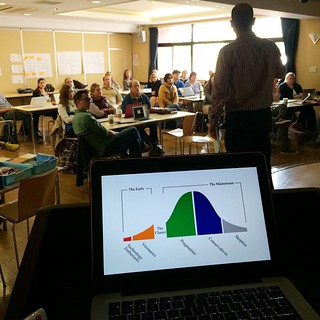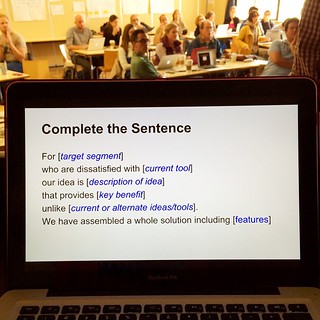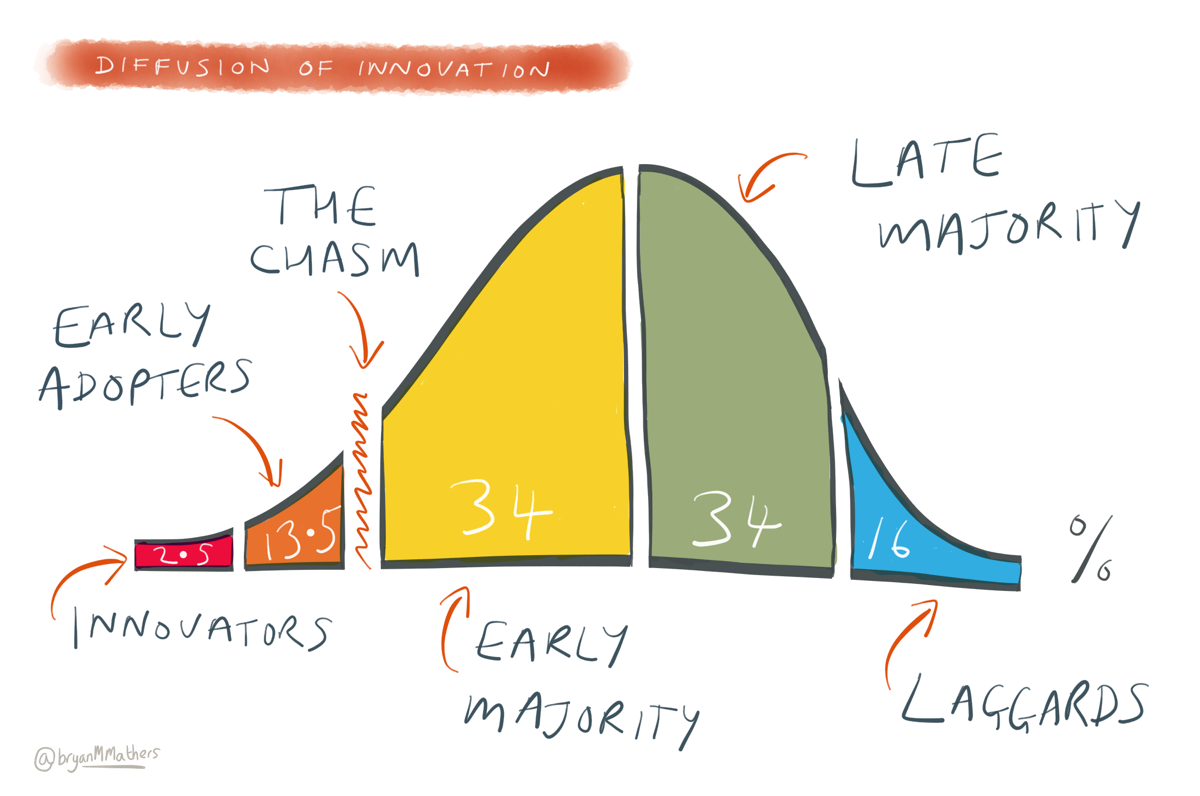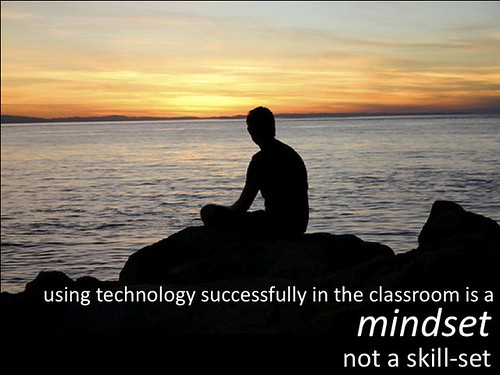We are all familiar with the Diffusion of Innovations theory or the Roger’s Adoption Curve, even if we don’t call it by the official name.
We all know at least one friend, family member or colleague that always buys the latest device because it’s new and exciting (that person owns a drone or a smart watch right now), and every type of consumer between that friend, colleague or family member who is an “innovator”, all the way through to the “laggard”, who questions every innovation until it’s so widely accepted they can’t avoid it anymore (that person either still complains about, or doesn’t yet own, a smart phone).
What’s interesting about this, to me anyway, is that there is a lot of research and experience in the consumer industry, particularly around technology, about how these different segments of the population respond to different marketing strategies. There’s actually (at least one) book about it called Crossing the Chasm, which is now on its third edition, originally published in 1991.
Since #beyondlaptops in April, (where Tico shared an extended version of his Learning2 talk highlighting the connections between marketing strategies and innovation in schools using Crossing the Chasm as his foundation) I’ve been thinking about how I can use these lessons from the consumer tech industry in my role as a technology coach.
Last week I posted this old (and controversial) article, with the following quote highlighted, on my Facebook account and it generated some great conversation, which got me thinking again…
“Case study after case study describe a common pattern inside schools: A handful of “early adopters” embrace innovative uses of new technology, while their colleagues make incremental or no changes to what they already do.”
We know that we have all of the consumer segments in our schools – from visionaries to pragmatists – and we know that we are responsible for supporting all of them.  Some teachers are already ready – they’re innovators or early adopters – and all we need to do is show them the tools or inspire them with an idea and they’re off and running. Easy. But what about the rest of the teaching population, including those that are risk averse or resistant to change?
Some teachers are already ready – they’re innovators or early adopters – and all we need to do is show them the tools or inspire them with an idea and they’re off and running. Easy. But what about the rest of the teaching population, including those that are risk averse or resistant to change?
Ultimately, my goal, as a coach, is to improve student learning through the use of innovative teaching and learning strategies. The best way for me to do this is to help all teachers develop an open-minded approach to the use of technology in the classroom. Since we need to do that with all segments of the population, can we apply the research and evidence from over 20 years of consumer technology marketing to our work in schools?
Here’s the thing, though, a school-based context is very different than the consumer market, and this is where I think we have lots of room for discussion:
Who are we marketing to?
In the consumer tech industry, companies are marketing and selling to individuals, directly.  In schools, however, the decisions about what hardware or software to use are often made by the leadership team in collaboration with the technology department (even in the best case scenario, all stakeholders are involved, but even in that case it’s usually a smaller focus group, not every single teacher, student or parent). And the actual purchasing is done by one central office and then devices are distributed out to teachers and students.
In schools, however, the decisions about what hardware or software to use are often made by the leadership team in collaboration with the technology department (even in the best case scenario, all stakeholders are involved, but even in that case it’s usually a smaller focus group, not every single teacher, student or parent). And the actual purchasing is done by one central office and then devices are distributed out to teachers and students.
For many, there may be very little connection between the decision to purchase and the desire to use the device. Beyond that, there is often no clear expectation or mandate to use the device in a certain way, so if teachers are uninterested in using them, they may not (and actually don’t, according to the article above).
Schools that understand this dynamic work very hard to ensure that all stakeholders understand the “why” behind the decision making process. When we developed our Connected Learning Community at YIS, we started our conversations (with a small focus group comprised of several members of all stakeholder groups) with the Simon Sinek TED talk, Start With the Why. Every time we reviewed or discussed the initiative, we came back to our “why”, and when we shared the results with larger faculty we did the same thing.
How does this tiered structure of decision making impact who we are marketing to?
What are we marketing?
As a coach, my priority is not what device or technology tool a teacher uses (although, I do, of course have my own opinions about what works best for learning), my priority is the teacher’s mindset. I’m not marketing a gadget, I’m marketing a belief about teaching and learning, and a pedagogical approach to learning with technology.
My goal is for teachers to understand that if they use sound pedagogy to design and teach a unit, the technology will enhance that experience. A well-designed unit with the addition of new and innovative technology will remain a well-designed unit – but so will a poorly-designed one.
So perhaps we’re not marketing the technology at all, we’re marketing a mindset, along with good teaching practices? If that’s the case, how do we define what we’re marketing in a way that is understandable and approachable for teachers?
How do we market effectively?
Crossing the Chasm focuses on the gap between early adopters and the mainstream market. Based on the research cited in the book, in order to be successful in marketing to the mainstream population, we can’t market our product the same way to both groups.
Basically the early adopters will buy in because of the new and exciting nature of the innovation – even if it’s not perfect yet and still has kinks to be worked out, which is a fun and easy part of a coach’s job. The problem is that the mainstream market wants to see a complete product, practical applications, and know exactly how it will work (and that it will work consistently). This is not an easy task when we’re actually really talking about good pedagogy, but we’re perceived to be talking about technology.
Thought Leadership from Annie Agnew on Vimeo.
If we know we have these different segments of the population, how do we market effectively to each of them?
Final Thoughts
It may seem strange to apply consumer marketing strategies to educational contexts, but as soon as I heard Tico talk about the book (and then read it for myself), I realized that there are so many connections we can make. The environment might be a little bit different, but it seems clear to me that we can’t use the same approach with all segments of the population, and if we know from actual market research what each segment is really looking for, we can be much more strategic in our thinking.
Have you tried applying this kind of thinking in your school? Do you have strategies that work for each segment of the population? How did it go?
Image Credits
- Diffusion of Innovation Model on Q & A: What is the Diffusion of Innovation Model in Marketing
- How do you pitch new ideas to different segments of the population? by Kim Cofino, Creative Commons licensed on Flickr
- Mindset not a Skillset by Kim Cofino, Creative Commons licensed on Flickr
- Diffusion of Innovation on Majority Opinion








